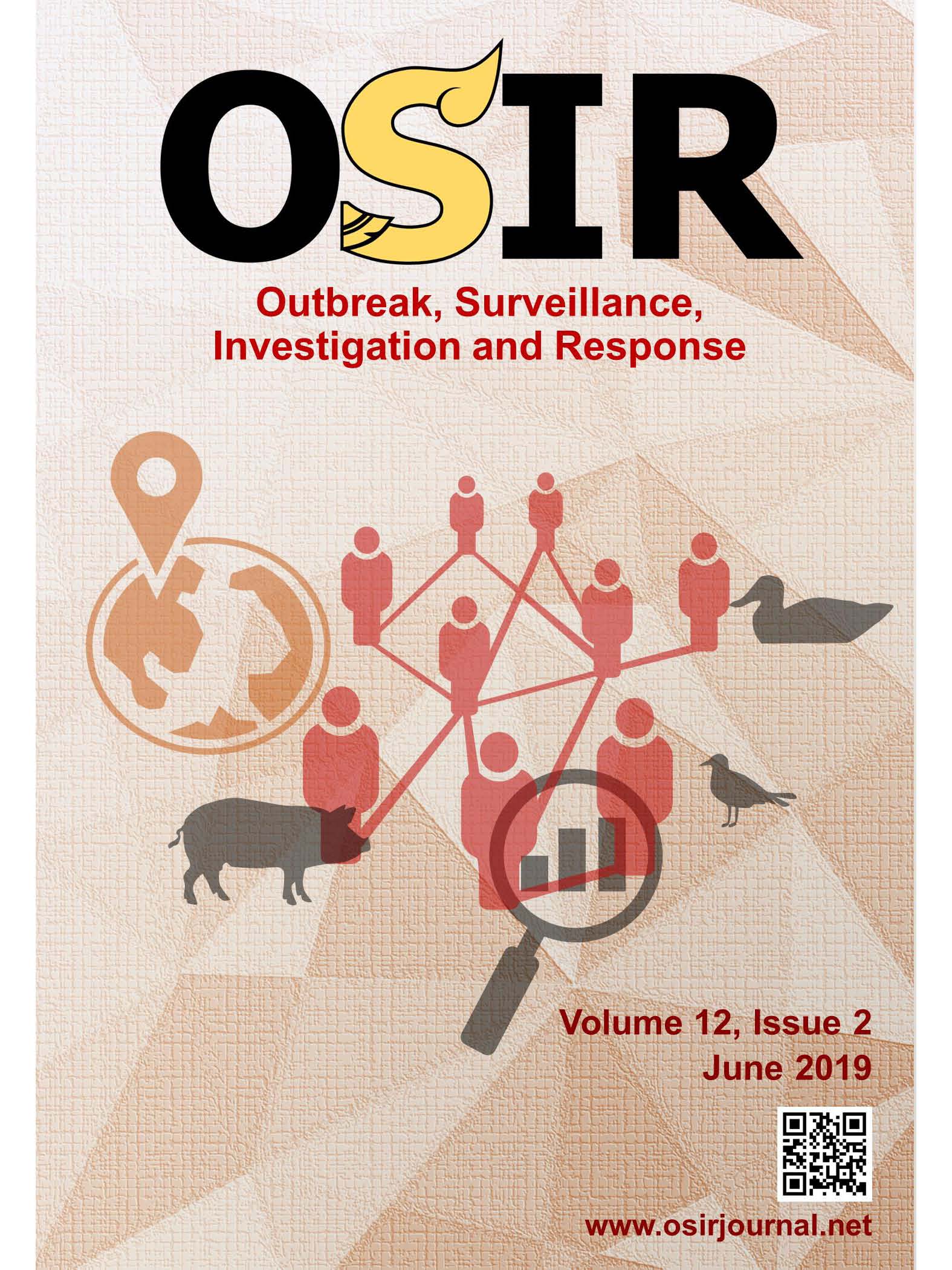A Large Scabies Outbreak at a Prison in Southern Thailand, April – August 2017
DOI:
https://doi.org/10.59096/osir.v12i2.262970Keywords:
Scabies, outbreak, prison, Thailand, control measureAbstract
Scabies is a neglected contagious skin disease and mostly occurs in crowded environment. After an increase in scabies cases at a prison, an investigation team was deployed. The objectives were to describe the epidemiological characteristics of cases, identify risk factors for infection and implement control measures. We defined a scabies confirmed case as a person with at least one itchy skin lesion, and diagnosed as scabies by both a physician and a dermatologist. We inspected the prison environment and observed sanitation practices. A case-control study was conducted among male inmates to identify risk factors for scabies. The overall attack rate was 29.4% among inmates. All 251 confirmed cases were typical scabies and 250 were male. The environmental inspection revealed poor hygiene and overcrowded at men’s zones. Sharing a bedroom (Adjusted odds ratio AOR = 9.72, 95% CI = 5.33-17.73) and sharing clothes with cases (AOR = 3.61, 95% CI = 1.66-7.84) were significantly associated with having scabies. After interventions of setting scabies surveillance, separation of new comers, universal treatment for all inmates, and disinfection of bedrooms, bedding and clothes with detergents, no more new cases were found. Improving sanitation especially in bedrooms, enhancing scabies detection, and early interventions after case detection could help prevent scabies outbreak in prisons.
References
Hengge UR, Currie BJ, Jager G, Lupi O, Schwartz RA. Scabies: a ubiquitous neglected skin disease. Lancet Infect Dis. 2006;6:769-79.
World Health Organization. Neglected tropical disease; Scabies. 2017 [cited 2017 Sep 1]. <https://www.who.int/neglected_diseases/diseases/scabies/en/>
GBD 2015 Disease and Injury Incidence and Prevalence Collaborators. Global, regional, and national incidence, prevalence, and years lived with disability for 310 diseases and injuries, 1990-2015: a systematic analysis for the Global Burden of Disease Study 2015. Lancet. 2016 Oct 8;388(10053):1545-602.
Centers for Disease Control and Prevention. Scabies: factsheet. 2017 [cited 2017 Sep 1]. <https://www.cdc.gov/parasites/scabies/fact_sheet.html>
Anderson KL, Strowd LC. Epidemiology, diagnosis, and treatment of scabies in a dermatology office. J Am Board Fam Med. 2017;30(1):78-84.
Hardy M, Engelman D, Steer A. Scabies: a clinical update. Australian family physician. 2017;46(5):264-8.
RJ, Steer AC, Engelman D, Walton S. Scabies in the developing world – its prevalence, complications, and management. Clin Microbiol Infect 2012;18(4):313-23.
Walton SF, Currie BJ. Problems in diagnosing scabies, a global disease in human and animal populations. Clin Microbiol Rev. 2007 Apr;20(2):268-79.
World Health Organization. Epidemiology and management of common skin diseases in children in developing countries. Geneva, Switzerland: World Health Organization; 2005 [cited 2017 Sep 1]. <https://apps.who.int/iris/handle/10665/69229>
Buehlmann M, Beltraminelli H, Strub C, Bircher A, Jordan X, Battegay M, et al. Scabies outbreak in an intensive care unit with 1,659 exposed individuals-key factors for controlling the outbreak. Infect Control Hosp Epidemiol. 2009;30(4):354-60.
Taxas Department of State Health Service, Health Service Region 1. Scabies fact sheet. 2008 [cited 2017 Sep 1]. <https://www.saylesschool.org/nursing/scabies.pdf>
Mounsey KE, Murray HC, King M, Oprescu F. Retrospective analysis of institutional scabies outbreaks from 1984 to 2013: lessons learned and moving forward. Epidemiol Infect. 2016;144(11):2462-71.
Bouvresse S, Chosidow O. Scabies in healthcare settings. Curr Opin Infect Dis. 2010;23(2):111-8.
Scheinfeld N. Controlling scabies in institutional settings: a review of medications, treatment models, and implementation. Am J Clin Dermatol. 2004;5(1):31-7.
Department of Correction. Guideline of scabies prevention and control measures among the prisoners. 2017. Thai [cited 2017 Aug 30].
Hewitt KA, Nalabanda A, Cassell JA. Scabies outbreaks in residential care homes: factors associated with late recognition, burden and impact. A mixed methods study in England. Epidemiol Infect. 2015;143(7):1542-51.
Jangiam W, Pattaruk O, Langlarlertsakul M. Scabies outbreak in prisons at Phuket provincial prison, Thailand, 1 January – 2 June 2016. Weekly Epidemiology Surveillance Report. 2016:47:769-75. Thai.
Sung J, Wangtiyong P, Siriwibul K, Suthipong P. Investigation of scabies outbreak among novices in a temple, northern Thailand, 2011. Thai [cited 2017 Aug 30]. <https://www.epiduthai.com>
Department of Correction. Guideline of scabies prevention and control measures among the prisoners. 2017. Thai [cited 2017 Aug 30]. <https://www.correct.go.th/osss/a8940_60.pdf>
Infectious Diseases Association of Thailand. Guideline of infectious disease prevention and control measures among the health care providers. Thai [cited 2017 Aug 30]. <https://bamras.ddc.moph.go.th/userfiles/16(2).pdf>
Institute of Dermatology. Clinical practice guideline for scabies. 2006. Thai [cited 2017 Aug 30]. <https://inderm.go.th/inderm2/file/10.Scabies.pdf>
Fuller LC. Epidemiology of scabies. Curr Opin Infect Dis. 2013;26(2):123-6.
Arlian LG, Vyszenski-Moher DL, Morgan MS. Mite and mite allergen removal during machine washing of laundry. J Allergy Clin Immunol. 2003 Jun;111(6):1269-73.
Downloads
Published
How to Cite
Issue
Section
License
Copyright (c) 2023 Outbreak, Surveillance, Investigation & Response (OSIR) Journal

This work is licensed under a Creative Commons Attribution-NonCommercial-NoDerivatives 4.0 International License.









